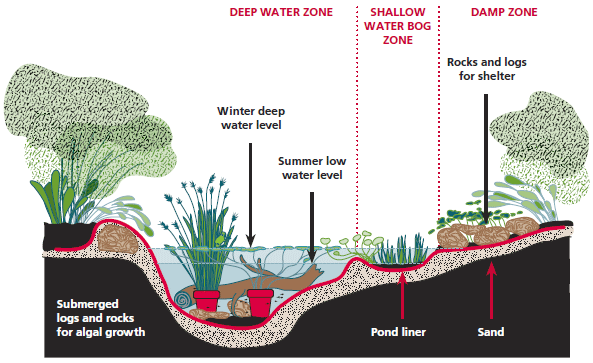Backyard Wetland - It's a Bog, A Quaking Bog, A Swamp, A Fen, A Marsh!
The University of Illinois Extension Service posted a cool article about how to use those last-to-dry spots in the yard.
Called Coles County Yard and Garden, the author wrote, " A bog tends to be waterlogged soil without any standing water (and therefore not a mosquito magnet).
A Quaking Bog is a floating mat of thickly woven mosses, rushes, and shrubs that forms across the surface of shallow ponds and may shimmy or shake when walked on.
A fen is an area of waterlogged soil that tends to be peaty and is fed by upwelling water. The difference between a bog and a fen is the water source and the acidity of the site. Bogs tend to be acidic; fens are more alkaline. Water flows into bogs solely through rainwater and run-off, while fens are also fed by groundwater.
A marsh has standing water – either temporary or permanent – and hosts vegetation such as cattails.
A swamp is a wetland area with trees.
Wetlands are one of the richest biological habitats on Earth. Unfortunately, for centuries we humans have viewed them as a physical constraint and have drained them for use by the ever-growing population.
The eradication of wetlands is a global phenomenon, primarily for agriculture. In addition, people mine bogs for peat for fuel and a soil conditioner. Recently, environmentalists recognize bogs for their role in regulating the global climate.
Bogs are unique communities that can be destroyed in a matter of days, but require hundreds of years to form naturally."
Click over to the link above for tips on building a bog.
Here are a few recommended bog/marsh plants
Plants for acidic bogs - There are many colorful varieties of Pitcher Plants (Sarracenia) which can live up to 50 years, hardy Sundews (Drosera), and Venus Flytrap (Dionaea).
For non-acidic bogs - Astilbe, Bamboo, Lady's Slipper Orchid, Day Lily, Siberian Iris, Creeping jenny, Rush, Royal Fern, Phlox, May apple, Solomon's Seal, Primrose, Great Bulrush, Golden Rod, Periwinkle, Trillium.
More plant ideas at http://www.gardeningknowhow.com/special/spaces/designing-bog-gardens.html
Also, at the bottom of the Coles County Yard and Garden newsetter page, there is a link to their other articles - lots to explore there.
Called Coles County Yard and Garden, the author wrote, " A bog tends to be waterlogged soil without any standing water (and therefore not a mosquito magnet).
A Quaking Bog is a floating mat of thickly woven mosses, rushes, and shrubs that forms across the surface of shallow ponds and may shimmy or shake when walked on.
A fen is an area of waterlogged soil that tends to be peaty and is fed by upwelling water. The difference between a bog and a fen is the water source and the acidity of the site. Bogs tend to be acidic; fens are more alkaline. Water flows into bogs solely through rainwater and run-off, while fens are also fed by groundwater.
A marsh has standing water – either temporary or permanent – and hosts vegetation such as cattails.
A swamp is a wetland area with trees.
 |
| http://www.sgaonline.org.au |
Wetlands are one of the richest biological habitats on Earth. Unfortunately, for centuries we humans have viewed them as a physical constraint and have drained them for use by the ever-growing population.
The eradication of wetlands is a global phenomenon, primarily for agriculture. In addition, people mine bogs for peat for fuel and a soil conditioner. Recently, environmentalists recognize bogs for their role in regulating the global climate.
Bogs are unique communities that can be destroyed in a matter of days, but require hundreds of years to form naturally."
Click over to the link above for tips on building a bog.
Here are a few recommended bog/marsh plants
Plants for acidic bogs - There are many colorful varieties of Pitcher Plants (Sarracenia) which can live up to 50 years, hardy Sundews (Drosera), and Venus Flytrap (Dionaea).
For non-acidic bogs - Astilbe, Bamboo, Lady's Slipper Orchid, Day Lily, Siberian Iris, Creeping jenny, Rush, Royal Fern, Phlox, May apple, Solomon's Seal, Primrose, Great Bulrush, Golden Rod, Periwinkle, Trillium.
More plant ideas at http://www.gardeningknowhow.com/special/spaces/designing-bog-gardens.html
Also, at the bottom of the Coles County Yard and Garden newsetter page, there is a link to their other articles - lots to explore there.



Comments
We have a couple of low places on our 2 acres slice of the earth.
A few months ago we asked our neighbor who had a borrowed back hoe to dig one down a couple of feet.
I'm hoping for a frog-attracting spot if we get enough moisture.
You could always visit water gardens near you in the meantime.